Marketing automation can, at times, seem like magic. Fortunately, it’s not.
We owe this revolution to powerful technology driven by genius innovation.
If the marketing industry were headed by a great wizard like Gandalf, he’d probably offer the following two points of wisdom:
A. In 2023, you need to reach out directly to potential customers and engage with them.
B. It’s better if this engagement is powered by technology to ensure scalability.
Alright, sure, he might not use those exact words, but the sentiment would be the same.
So, keeping Gandalf’s wisdom in mind, let’s go ahead and explore how to reshape customer engagement with the help of marketing automation and what technologies you can keep in mind to future-proof your business.
The current state of marketing automation
The only constant in marketing is change. Let’s take a quick look at the current state of marketing automation as we know it.
1. Recapping established marketing automation practices
Before we move forward to talk about the future of innovative technologies, let’s quickly recap some of the best practices you need to keep in mind before you switch to using marketing automation software in your day-to-day life:
- Always define a clear reason as to why you need to use this technology and what benefits it can provide you (e.g., can it help you reduce those repetitive tasks and save X hours of workload?).
- If you’re opting for marketing automation for your customer’s benefit, don’t forget to analyze the customer journey to understand which pain points it can help solve.
- Always consider adoption time and challenges for your marketing teams (more on this later).
2. Key challenges faced by businesses
After speaking to the subject matter experts (SME) in our network, we understood that some of the issues faced by them vis-a-vis adoption are:
- The need to personalize content even after integrating a robot.
- Ensuing communication stays relevant and isn’t motivated by data skews.
- Data breaches and loss of information due to the excessive use of tech in a marketing strategy.
- Inability to access customer thoughts and insights by not having a 1:1 conversation with qualified leads.
Here are some other challenges:
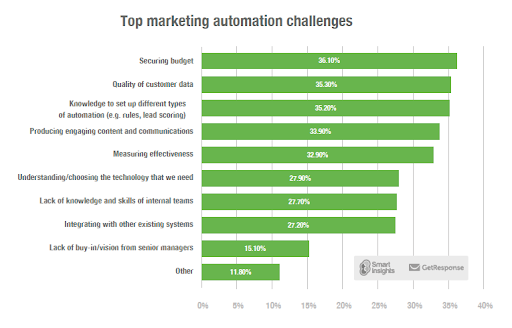
3. How advanced users have maximized traditional marketing automation techniques
Smart marketers (and sales teams) understand when to automate and when not to — that’s to say, they know how to strike a balance between human intervention and marketing automation tools.
A perfect example is staff scheduling.
By developing an organized staff scheduling system via an automated tool, you can instantly deliver employees’ schedules and ensure nonstop efficiency. This helps avoid scheduling conflicts and allows your team to focus on the tasks at hand.
When your employees optimize their time, your customers can count on exceptional service.
While technology can help with inspiration, provide quantitive data, and scale easily, human interference is needed for creative input, qualitative data, and decision-making.
Emerging technologies and their impact on marketing automation
What technology is sprouting from the woodwork? And what does that mean for marketing automation? Let’s take a closer look.
1. Artificial intelligence (AI) and machine learning (ML) as tools in automation
AI and ML are ruling the marketing game, with folks being interested in technologies like ChatGPT, HubSpot, Salesforce, and Drift (read: marketing automation platforms), to make the most of their marketing campaigns.
At VBOUT, we developed an AI-powered chatbot to assist marketers even more with content creation. This tool creates prompts for ChatGPT for generating social media posts or email campaign subject lines. It’s a versatile tool that helps streamline one more step in your content creation process.
Here’s a specific use case demonstrating how brands can use AI and ML:
Personalized content creation and delivery
Today, customers are daunted by marketing communications left, right, and center.
So, the one way to reach out to them to ensure they remember you is to provide highly personalized, relevant, and insightful content at the right time (e.g., there are time zone considerations you might need to account for).
Let’s consider an example: House of Joppa, a Catholic home decor store, manages to nail the task of personalized content creation and delivery by checking its website analytics and asking customers for their thoughts on the review page to get qualitative data.
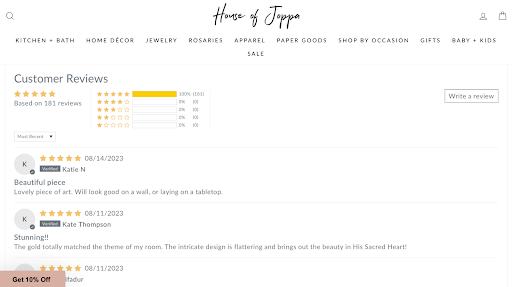
By adeptly harnessing both customer behavior tools and reviews, House of Joppa can craft hyper-personalized content, whether in the form of retargeting campaigns or fresh marketing endeavors.
The result? Happier customers and higher conversion rates. It’s a win-win.
2. Voice search and virtual assistants
Another technology that’s been particularly useful in the age of automation? Voice search and virtual assistant.
Consider the convenience technologies like Alexa and Siri offer. Or, think about the benefits text-to-speech software provides to people with disabilities. As content is read aloud to users, businesses have a unique opportunity to engage audiences in a more personalized and immersive manner.
Brands can leverage this technology to ensure their content is accessible, especially for those who prefer auditory learning or have visual impairments.
Additionally, integrating text-to-speech functionalities can enhance user experience, making content consumption more flexible and adaptable to various user needs.
Optimizing content for voice search
So how do you optimize content to rank highly in voice search? Here are a few things to keep in mind when creating relevant content for voice search:
- Embedding long-tail keywords
- Using a conversational tone
- Optimizing for local search
- Keeping search intent in mind
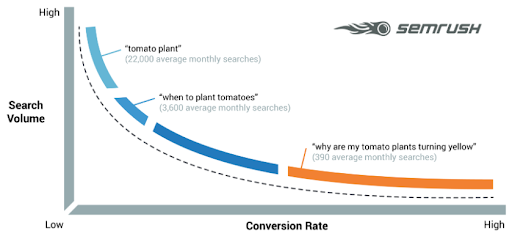
3. Augmented reality (AR) and virtual reality (VR)
AR and VR are making a comeback, especially since sister technologies like the metaverse have gone through a wave of popularity. So, let’s look at some of the benefits marketing automation technology offers:
Immersive brand experiences
Your marketing department can offer immersive brand experiences through 360-degree videos, virtual events, virtual try-ons, advertising, virtual storytelling, etc.
The result? A personalized experience. One of the many benefits of marketing automation.
Interactive product demonstrations
AR and VR allow you to try on looks based on your style, customize product demos, interact with the product in real-time, get full demonstrations, etc.
4. Internet of Things (IoT) integration
IoT refers to using smart devices that help you with contextual and relevant insights to improve your marketing game.
Here are a few use cases where you can use IoT:
Customized messaging based on real-time data
You can provide your customers with personalized messages like “Hey! You visited our store recently. Here’s a discount code for you.” with the help of IoT technologies like in-store beacons.
Smart devices and personalized marketing campaigns
Smart IoT devices can also provide a treasure trove of data, which can further improve your marketing automation strategy. For example, with the help of wearable devices, data about your healthcare customers’ lifestyles is easily available.
Innovative strategies for future-proof marketing automation
1. Hyper-personalize at scale
Use AI-driven customer segmentation
One of the best use cases for AI is customer segmentation. Especially in the digital age, reaching out to your customers directly among the noise can be a bit of an edge, so it makes sense to do so.
Companies like Campus.edu are even stepping forward to do customer segmentation in a different way.
That’s to say, instead of completely relying on AI to do segmentation, they rely on it to collate all the data in the necessary sections and then ask the students which sections they’d like to be segmented into.
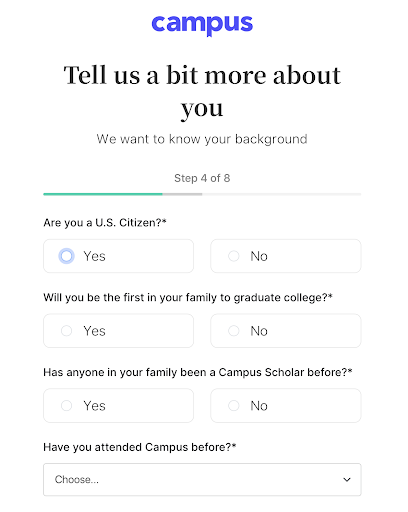
Dynamic content based on real-time behaviors
Next, consider the Hers blog post on “How to Get Antidepressants” as an example.
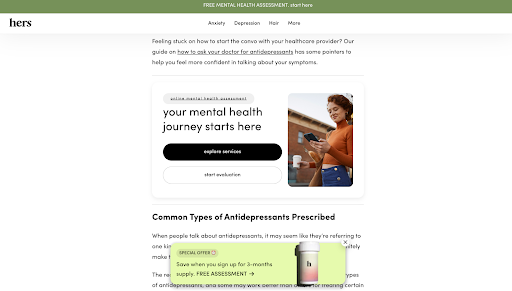
They implemented a CTA in the middle of the blog to offer a free assessment (the assessment then goes on to ask a couple of questions to the reader to know more about their journey).
This way, Hers, a healthcare company, can create a database of leads based on their real-time behaviors and actions while personalizing their experiences.
2. Multi-channel automation and integration
Seamless orchestration across various platforms
If you’re running a campaign for your brand (e.g., a Black Friday sale), then you must communicate it across all your marketing platforms, including your website, your retail stores, your social media posts, and email marketing campaigns.
To ensure this happens seamlessly across marketing channels and to reduce human-made errors, using AI can prove to be particularly helpful.
Coordinated messaging for customized customer experiences
Think of this as an omnichannel way of marketing. Let’s say your customers are on your social page browsing your ad — the link or the CTA they click on should have the same offer as mentioned in the ad.
And if you’re using a variation of ads, customize each experience. In this instance, you can use AI technologies to segment your audiences, generate ad copies, create content, schedule posts, and optimize your processes.
FYI: This is just one example, but customized and coordinated messaging goes beyond just this and even extends to simple things like tonality, bio, info, content style, etc.
3. Embrace chatbots and conversational marketing
AI-powered chatbots for instant customer engagement
In the instance you’re dealing with millions of customers and thousands of customer support tickets, you need AI-powered chatbots to engage with them and solve their most basic queries.
For example, if a lead asks how to set up an account, the chatbot can directly guide them without interference from your sales and customer support teams (and this also saves hours of effort on their end).
Creating interactive workflows
Interactive workflows that walk you through the product in real-time are one of the best ways to educate your customers about the product.
A product demo that’s entirely one-sided can cause customers to forget about your product features, but that’s where interactive workflows shine — in helping customers remember.
Navigating the transition to advanced marketing automation
1. Assess your current automation maturity
To begin with, assess the current use of automation in different departments of your organization. For example, do you use staff scheduling tools? Do you use text-to-speech software to increase content creation or rely on social media scheduling tools?
2. Identify areas for innovation and improvement
Next up, you need to sit down and analyze areas of improvement vis-a-vis marketing automation. Consider questions like:
- What departments need automation the most?
- How can automation help them?
- What types of technologies can I use?
- How will it affect their workflows?
- What benefits will this bring?
3. Strategize for seamless integration of new technologies
The last step in this list is to strategize for seamless integration. That’s to say, if you’ve already identified which type of technology you’d like to use, consider:
- Which apps to stick with?
- How long would the product integration time be?
- How do we educate departments about this tech?
- Can it integrate with my other solution?
- And other similar questions
Begin your automation journey with VBOUT
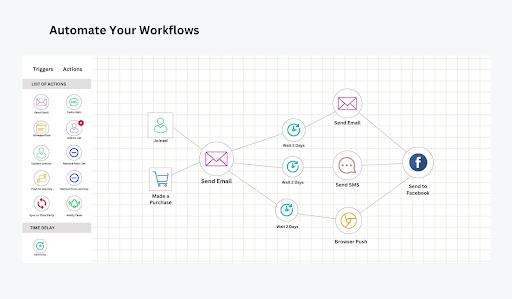
We all believe marketing automation solutions are a complex and tricky process. But a task that has to be done nonetheless to stay in touch with the future, have an edge over your competitors, and for long-term results. And you have a better chance of boosting your marketing ROI.
However, marketing automation doesn’t always need to be difficult because technologies like VBOUT can help you automate your marketing efforts in the easiest and fastest way.
With VBOUT, you can integrate with your favorite solutions and automate time-consuming tasks like email marketing, lead generation, social media activities, pipeline management, landing page development, and lots more!
If you’re interested in finding out more about our capabilities, click here to book your free demo!
Don’t forget to share this article
